Description and operation
Electronic parking brake (EPB) is motor driven braking system operated by a
switch instead of pulling or depressing the lever to engage the brake. Pressing
the button will deliver the electronic signal to ECU, and the ECU operates EPB
actuator which consists of the gear and the motor. Then the motor inside the
EPB spins and advances the nuts inside the caliper to engage braking force.
EPB ECU, one of the parts consisting the EPB, recognizes the signals from various
sensors to perform self-diagnosis and controls EPB according to the EPB control
logic.
Main Function
|
1. |
Static Braking Mode
The operation and the cancellation at the stop condition of the vehicle
|
(1) |
The operation condition: Pull the EPB switch irrespective of
the brake pedal pressed condition. (Pull).
|
– |
The Vehicle speed <= 3kph
|
|
|
(2) |
The cancellation condition: Push the EPB switch at the ignition
switch on & the brake pedal pressed condition. (Push).
|
|
|
2. |
Dynamic Braking Function
Dynamic Braking Function (DBF) : The DBF is the braking function at
the driving condition, it can operate the EPB system and cancel it at
the vehicle driving condition. This function will be used while foreign
materials get in between the brake pedal or the brake hydraulic line
can not be operated.
|
(1) |
The operation condition
It operated only when the vehicle speed is faster than 3kph
and the EPB switch is pushed.
|
|
(2) |
The cancellation condition: It canceled when the pulling of
the EPB switch is stopped.
|
|
(3) |
Principle of Operation
|
– |
ESP system is normal condition: EPB requests applying
pressure of brake to ESP system.
|
|
– |
ESP system is abnormal condition: EPB operates the parking
brake for reduction of speed.
|
|
|
(4) |
Peculiarity
Anti-lock is operated when occurring wheel lock. Parking lamp
on the cluster illuminates in the case of emergency braking.
|
|
|
3. |
Drive Away Release
Convenient for drivers, EPB is automatically released when driver shift
from P into another (R/N/D/S) during braking.
|
|
4. |
Latching Run
This is reconnection function to operate EPB normally after emergency
release.
Operation
|
(1) |
After emergency release, when operating EPB first, the parking
brake is operated to the maximum.
|
|
(2) |
Reconnection function can be performed with the diagnostic tool.
|
|
(3) |
After testing for reconnection 5 times, EPB isn’t be operated
in the present ignition switch cycle when EPB doesn’t reconnect
normally.
|
|
|
5. |
Bedding Mode
You must do "Bedding in process" for optimizing the initial operation
performance of EPB after replacing the parking brake shoe and rear brake
disc.
Bedding in Process
|
(1) |
Ignition on, start engine.
|
|
(2) |
Apply the foot brake 2 times within 10 seconds and hold applied
after the last application.
|
|
(3) |
Apply the EPB switch 4 times, followed by 3 release applications
within 10 seconds.
|
|
(4) |
The linings must be bedded-in by 6 repeated dynamic braking
procedures from 30-35 km/h to vehicle standstill. (If the vehicle
speed is over 50 km/h at the Bedding Mode, it is automatically
released.)
|
|
(5) |
After each braking cycle a cooling period for the linings is
necessary to prevent lining damage.
|
– |
The cooling can either be carried out via driving a
500 m distance after each braking cycle without any
apply of the EPB or via keeping the vehicle in standstill
for 1 minute after each braking.
|
|
|
|
6. |
AVH (Automatic Vehicle Hold)
AVH supports to keep a stop condition of the vehicle by hydraulic brake
at a stop.
|
(1) |
Condition for operation
|
– |
Fastening driver seat belt
|
|
– |
A gear shift is not P-range
|
|
– |
Perfect stop condition with hitting the brake pedal.
|
|
|
(2) |
AVH function holds stop condition of the vehicle for maximum
5 minutes.
VDC valve keeps stop condition because of intercept the oil
passage with pressure occurred from brake pedal.
|
|
(3) |
An accumulated time of AVH operation : Max. 30min
|
|
(4) |
Automatic release function
AVH mode is released when driver attempts starting a vehicle
by pedaling an acceleration pedal at the D/ S/ R range.
|
|
(5) |
Automatically convert AVH to EPB
AVH will convert EPB operation automatically if any one satisfy
conditions below.
[Normal conversion case]
|
– |
In the case of driver door open & Driver seat belt release
at the same time
|
|
– |
In the case of opening the hood while the shift lever
is D or S.
|
|
– |
In the case of opening the trunk while the shift lever
is R
|
|
– |
In the case of over 5 minutes of AVH operation time
|
|
– |
Stop at a slope of twenty five degrees
|
[Abnormal conversion case]
|
– |
When sensing detailed motion of the vehicle.
|
|
– |
When sensing the fault of ESP hydraulic system.
|
|
|
Warning Lamp
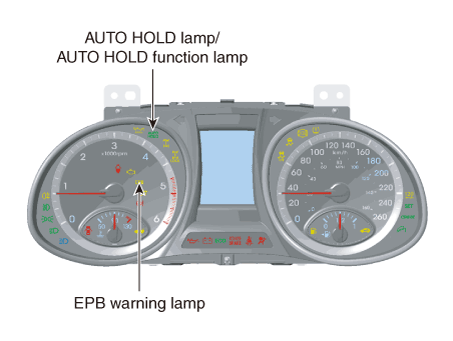
|
1. |
EPB warning lamp
EPB warning lamp indicates the EPB cut and malfunction.
EPB warning lamp comes ON below cases.
|
(1) |
EPB warning lamp comes on for 3 seconds after the ignition switch
is ON. If EPB system is working properly, EPB warning lamp goes
OFF
|
|
(2) |
If EPB system is not working properly, EPB warning lamp comes
ON
|
|
(3) |
Under diagnosis mode, EPB warning lamp comes ON
|
|
|
2. |
AUTO HOLD lamp / AUTO HOLD function lamp
|
(1) |
AUTO HOLD switch ON
|
A. |
Brake system operates automatically when vehicle speed
is "0", in the case of parking or waiting at a red light,
during braking (AUTO HOLD function lamp : Green)
|
|
B. |
Brake system is released automatically when step on
the accelerator pedal. (AUTO HOLD lamp : White)
|
|
|
(2) |
AUTO HOLD switch OFF : AUTO HOLD function does not operate.
|
|
Components and components location

1. ESP Control
Module (HECU)
2. EPB switch
|
3. Electronic
Parking Brake (EPB) actuator
|
Schematic diagrams
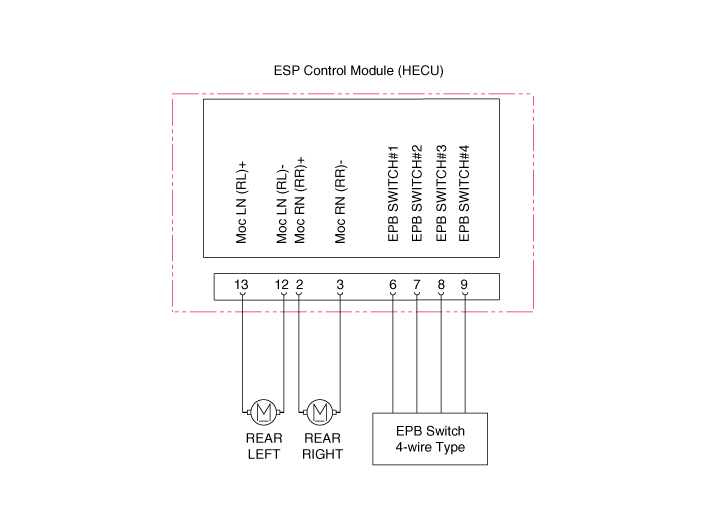
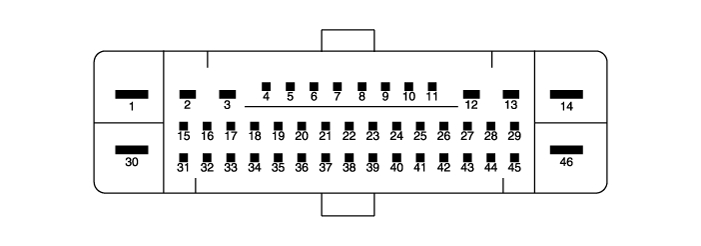
Pin No
|
Fuction
|
Pin No
|
Fuction
|
6
|
Electrical parking brake signal 1
|
2
|
Rear right EPB motor power
|
7
|
Electrical parking brake signal 2
|
3
|
Rear right EPB motor ground
|
8
|
Electrical parking brake signal 3
|
12
|
Rear left EPB motor ground
|
9
|
Electrical parking brake signal 4
|
13
|
Rear left EPB motor power
|
Repair procedures
| •
|
Be careful not to damage the parts located under the vehicle
(floor under cover, fuel filter, fuel tank and canister) when
raising the vehicle using the lift.
(Refer to General Information - "Lift and Support Points")
|
|
[EPB Switch]
|
1. |
Turn ignition switch off and disconnect the battery (-) cable from the
battery.
|
|
2. |
Remove the floor console upper cover.
(Refer to Body - "Floor Console")
|
|
3. |
Disconnect the EPB switch connector (A).
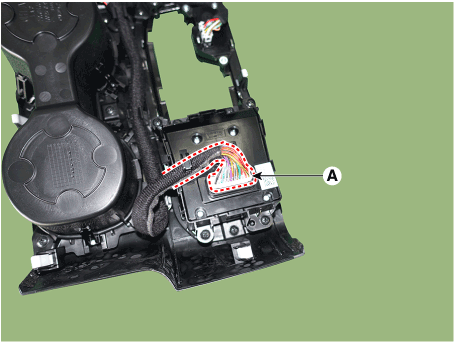
|
|
4. |
Remove the EPB switch (A) after loosening the screw.
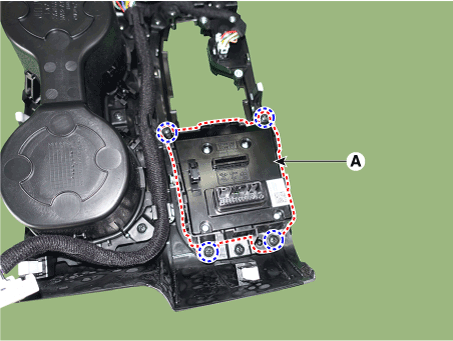
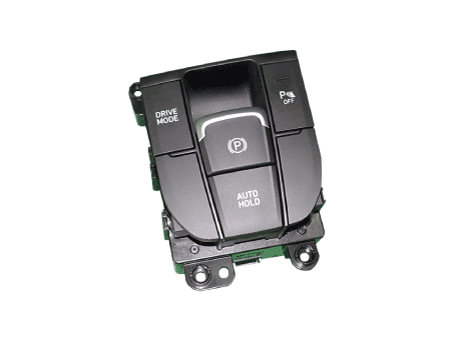
|
[EPB Actuator]
|
1. |
Turn ignition switch off and disconnect the battery (-) cable from the
battery.
|
|
2. |
Remove the rear wheel and tire.
|
|
3. |
Remove the EPB actuator from rear caliper.
(Refer to Brake System - "Rear Disc Brake")
|
Repair procedures Inspection Operation and Leakage Check 1. Brake Booster (A) (1) Check brake operation by applying the brakes during a test drive. If the brakes do not work properly, check the brake booster. ...
Components and components location Components 1. ABS control module (HECU) 2. Front wheel speed sensor 3. Rear wheel speed sensor 4. ABS warning lamp 5. Parking brake/ EBD Description and operation Description ...
See also:
Instrument Cluster. Description
and Operation
Description Communication Network Diagram Abbreviation Explanation C_CAN Chassis Controller Area Network B_CAN Body Controller Area Network MM_CAN Multi media Controller Area Network SMK Smart Key ECU ...
Front Seat Shield Inner Cover. Repair procedures
Replacement • Put on gloves to protect your hands. • When prying with a flat-tip screwdriver, wrap it with protective tape, and apply protective tape around the related parts, to prevent damage. • ...
Cluster Fascia Panel. Repair procedures
Replacement • Put on gloves to protect your hands. • When prying with a flat-tip screwdriver, wrap it with protective tape, and apply protective tape around the related parts, to prevent damage. • ...
 Hyundai Santa Fe (TM): Parking Brake System. Electronic Parking Brake (EPB)
Hyundai Santa Fe (TM): Parking Brake System. Electronic Parking Brake (EPB)



 Brake System
Brake System ESP(Electronic Stability Program) System
ESP(Electronic Stability Program) System



